Capture of Valdivia
| Capture of Valdivia | |||||||
|---|---|---|---|---|---|---|---|
| Part of the Chilean War of Independence | |||||||
 A painting of the fall of Valdivia in the Chilean naval and maritime museum |
|||||||
|
|||||||
| Belligerents | |||||||
| Commanders and leaders | |||||||
| Strength | |||||||
| 350 | 1,606 118 cannons |
||||||
| Casualties and losses | |||||||
| 7 killed 19 wounded | ~100 killed 106 prisoners |
||||||

The Capture of Valdivia was a battle in the Chilean War of Independence between Spanish forces commanded by Colonel Manuel Montoya and the Chilean forces under the command of Lord Cochrane, held on 3 and 4 February 1820.
Background
After failing to capture the Spanish fortress of Real Felipe in El Callao, Cochrane decided to assault the city of Valdivia, the most fortified place in South America at the time. Valdivia was considered a threat to Chilean independence as it was a stronghold and supply base for Spanish troops. Valdivia provided a safe landing site for sending reinforcements to the loyalist guerrilla fighting the Guerra a muerte in the area of La Frontera.
Valdivia was isolated from the rest of Chile by native Mapuche territory, and the only entrance to Valdivia was Corral Bay, at the mouth of Valdivia River. The bay was protected by several forts built to prevent pirate raids or any attack from a foreign nation.
Fortifications
The defenses at Valdivia consisted of a number of forts and defensive positions. On the South side of the habour were four forts - Fort Ingles, Fort San Carlos, Fort Amargos and Fort Chorocomayo. Further inland was Corral Castle to defend against a landward assault. On the Northern side was the stone walled Fort Niebla. Mancera Island in the centre of the habour was also heavily garrisoned.
Battle
Facing these powerful fortifications, Lord Cochrane decided to attack the forts from the land in an amphibious nighttime operation. The troops landed south of the bay on the Aguada del Ingles (the English Beach). Taken by surprise, the Fort Ingles was captured quickly, with the fugitives running towards the next fort, Fort San Carlos. The attackers got in among the fleeing Spanish troops and in the confusion were able to capture San Carlos and subsequently the other two forts on the south side of the habour, with only Fort Chorocomayo showing brief resistance before capitulating.
After the success of the attack on the forts of the southern shore, Cochrane called a halt for the night. He anticipated an altogether grimmer fight in the morning to capture the remaining fortifications, as he had lost the element of surprise. However, in the morning the commanders of the other forts unexpectedly decided to surrender without a fight, with the garrisons of Fort Niebla and Mancera Island retreating upstream. The town of Valdivia surrendered soon after.
Aftermath
The Spanish troops inside Valdivia itself sacked the city and then went to Osorno. These troops later moved to reinforce Chiloé Island which was the last Spanish possession in Chile. Lord Cochrane tried to conquer the island without success.
The capture of Valdivia effectively ended the last vestiges of Spanish power in mainland Chile and opened up the way for Chilean and Peruvian independence.
Additional information
External links and sources
- History of the fortifications of Valdivia (Spanish)
- Capture of Valdivia (Spanish)
Bibliography
- Gonzalo Contreras. Lord Cochrane bajo la bandera de Chile. Santiago, Editorial Zig-Zag, 1993, ISBN 956-12-0812-1
- Francisco Encina. Historia de Chile. Santiago, Editorial Nascimiento, 1949.
- Jaime Eyzaguirre. O'Higgins. Santiago, Editorial Zig-Zag, 1982, ISBN 956-12-1022-3
- Renato Valenzuela Ugarte. Bernardo O´Higgins. El Estado de Chile y el Poder Naval. Santiago, Editorial Andrés Bello, ISBN 956-13-1604-8
- Estado Mayor del Ejército de Chile. Historia Militar de Chile. Memorial del Ejército de Chile Nº 351. 1969
Coordinates: 39°52′S 73°26′W / 39.867°S 73.433°W